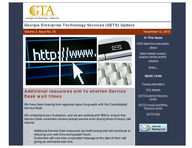Georgia Enterprise Technology Services (GETS) Update
Volume 2, Issue No. 23
November 12, 2010
In This Issue
AT&T beginning voice system refresh
State's disaster recovery program reaches another
milestone
Briefly...
Quick Links
Additional resources aim to shorten Service Desk wait times
We have been hearing from agencies about long waits with the Consolidated Service Desk.
We understand your frustration, and we are working with IBM to ensure that Service Desk customers receive prompt service even during times of heavy call volume:
Previous Newsletters
GTA Website
GETS Customer Resource Center
GETS Financial and Billing Resource Center
GETS FAQs
q Additional Service Desk resources are forthcoming that will contribute to reducing your wait time during peak hours.
q Customers will now hear a recorded message at the start of their call giving an estimated wait time.
q All agents are being kept up-to-date on projects, transformation activities and any issues they should anticipate.
q The Service Desk will continue to use messages to alert callers to any widespread outages or problems.
We will continue to closely monitor the performance of the Service Desk and the impact of the improvements we are making.
Thank you for your ongoing support.
Patrick Moore State Chief Information Officer GTA Executive Director
AT&T beginning voice system refresh
Voice systems included in the GETS contract will undergo a refresh over the next five years. The aim is to replace old, outdated equipment with new, current technology, equipment and capabilities. The refresh will encompass approximately 450 current key systems, 24 PBX systems and more than 115,000 Centrex/single line/P-phone/ISDN lines.
Agencies will experience many benefits, including:
q better voice system performance q fewer maintenance issues q improved management capability q updated configurations q additional features
Further, agencies will not incur upfront costs for new consoles, handsets, system design and installation. Each agency will only be responsible for miscellaneous costs, such as any interior cabling upgrades that might be necessary.
Using a "like for like" approach, the refresh effort will use equivalent systems and equipment unless customer requirements dictate a different solution. For
example, an old PBX system will be replaced with a new PBX console, new handsets and updated capabilities.
AT&T and GTA will work with each agency to plan their refresh, from confirming priorities and contacts and gathering business requirements by site, to developing an implementation schedule, installing and testing new systems, and training users.
Sites have been grouped into five implementation "waves" over the next five years based on several factors, such as the age of the system, number of maintenance problems, and type of equipment. In general, the plan is to begin with the most critical sites within each agency.
In advance of each wave, AT&T Account Managers or GTA Service Delivery Consultants will contact affected agencies to arrange a kickoff meeting to discuss the program in greater detail.
Back to top
State's disaster recovery program reaches another milestone
The state has reached another milestone in building a strong disaster recovery program for the IT enterprise. In October, GTA and IBM conducted a second disaster recovery exercise.
While smaller in scope and duration than the first exercise last August, it was no less important to identifying what works well and what needs greater attention going forward. A total of four agencies participated in October's exercise compared to nine in August. It lasted 48 hours instead of 96 and tested nine applications as opposed to 41. While the August exercise was tape-based only, last month's used both tapes and replication.
Just as the first exercise helped to set priorities for the second, these latest tests brought to light additional work needed before the third exercise, which is currently scheduled for February 2011. In particular, the recovery of mainframe
applications using replicated data went well, and the test of the UNIX environment and webMethods, which enables information sharing among agencies, also proved successful. However, a few challenges remain in the Windows environment and with network connectivity. These issues were not unexpected; in fact, the purpose of the exercises is to determine where problems exist so they can be fixed.
With agency involvement, GTA will continue building the kind of comprehensive and reliable disaster recovery program needed to ensure each agency's and the state's critical business functions can operate even during a disaster. As part of these efforts, GTA plans to work closely with agencies to refine both priorities and times for recovering the critical business applications supporting those functions.
Back to top
Briefly...
Several enhancements were made to the Service Catalog (OrderNow!) in November. Here is brief information about a few of the updates.
You will find updated reference materials, including Frequently Asked Questions and Terms Glossary documents particularly for MNS-only customers and a revised Service Catalog Quick Reference Guide.
Also new this month is a revised process for requesting RACF user IDs. Requests are now made through the Service Catalog, eliminating the practice of faxing request forms. The online form includes all the information previously provided on the hard copy form.
A change to the Asset Management Access Only category removed the price associated with workstation disposals and noted that disposal requests should be used for green-tagged assets only.
You can find a complete listing of Service Catalog updates on the GETS portal.
Back to top We welcome your comments about service delivery, the state's IT transformation and related topics. You can submit comments online or call our toll-free number to leave a recorded message.
Email Marketing by
